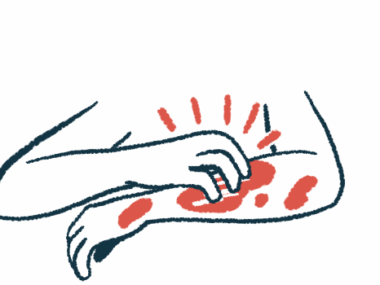Dupilumab effective for DEB pruriginosa in 22-year-old: Report
Treatment helpful in newly ID'd type of dystrophic epidermolysis bullosa
Written by |

A young woman whose dystrophic epidermolysis bullosa (DEB) pruriginosa was caused by a newly identified gene mutation responded well to treatment with dupilumab, a medication that relieves itching, researchers in China report.
Dupilumab, approved as Dupixent for several other diseases, is given as a subcutaneous or under-the-skin injection. In this case, it not only helped the woman’s skin feel less itchy, but also reduced reddening of the skin, called erythema, and thinned plaques, or scaly patches of skin, the researchers noted.
The woman did not experience any side effects related to the medication.
This case adds to previous reports suggesting the use of dupilumab for DEB pruriginosa. According to the researchers, “such reports, however, remain limited and somewhat speculative.”
The report, “Identification of a novel COL7A1 variant associated with dystrophic epidermolysis bullosa pruriginosa responding effectively to dupilumab,” was published in the journal Molecular Genetics & Genomic Medicine.
Newly identified mutation believed to cause DEB pruriginosa
Epidermolysis bullosa makes the skin fragile and likely to blister or tear. In DEB, this is caused by mutations in COL7A1, a gene that encodes part of a protein called type VII collagen. This protein is essential for binding the layers of skin together.
Now, the researchers reported the successful use of dupilumab to treat a 22-year-old with DEB pruriginosa, a rare form of DEB characterized by milia, also known as milk spots, and intense, hard-to-treat pruritus, or itching.
Developed jointly by Sanofi and Regeneron, dupilumab — marketed as Dupixent in the U.S. and Europe for other conditions — is an antibody that blocks signaling by interleukins 4 and 13, two chemical messengers that contribute to inflammation.
The medication, here used off-label, is approved for eczema or atopic dermatitis, asthma, chronic rhinosinusitis with nasal polyposis, prurigo nodularis, and eosinophilic esophagitis.
According to the report, the woman had a history of blisters and milia since childhood. These lesions often turned into itchy, scaly patches, and sometimes sores, on her limbs. She was diagnosed with eczema or prurigo nodularis, a skin disease characterized by firm, itchy lumps.
The woman was given glucocorticoids, applied directly onto the skin, to combat inflammation, and oral antihistamines, a common treatment for allergies. She also tried bloodletting, the practice of withdrawing blood, as well as traditional Chinese medicine, but she did not respond to any of these treatments.
Her symptoms worsened in young adulthood, the researchers reported. Their physical examination of her revealed multiple skin-colored and dark-red, scarred papules or nodules of different sizes on her upper body and arms.
Blood testing revealed normal levels of immunoglobulin E, a type of antibody linked to allergies. However, when the researchers looked at a skin sample under a microscope, they found that the skin layers were split apart.
The skin sample also had enlarged blood vessels but few inflammatory cells. Based on these findings, the researchers made a diagnosis of DEB pruriginosa.
“Upon further investigation and based on her medical history, it was discovered that seven other family members also had similar symptoms,” they wrote.
Genetic testing revealed a mutation in the COL7A1 gene. The mutation, called c.8110G>A (Gly2704Arg), was considered likely to cause the disease.
Treatment significantly reduced symptoms
Previous reports have described the use of dupilumab to treat DEB pruriginosa, so the woman was started on the medication at an initial loading dose of 600 mg, followed by a dose of 300 mg given subcutaneously every other week.
The treatment made her skin significantly less itchy, reduced skin redness, eased the severity of scales and crusts, and thinned plaques.
After 14 weeks, or about three months, “the patient’s quality of life improved substantially,” the researchers said. This was indicated by a decrease from 7 to 2 on the visual analog scale, which rates pain on a scale of 10, and from 19 to 7 on the standard Dermatology Life Quality Index, in which 30 represents the greatest impact on quality of life.
At one year of treatment, the woman continued to experience relief from itching and continued reduction of skin lesions, with no side effects related to dupilumab.
According to the researchers, this is the first case of a person with DEB pruriginosa caused by a c.8110G>A (Gly2704Arg) mutation “who responded positively to dupilumab treatment without experiencing any serious side effects.”






